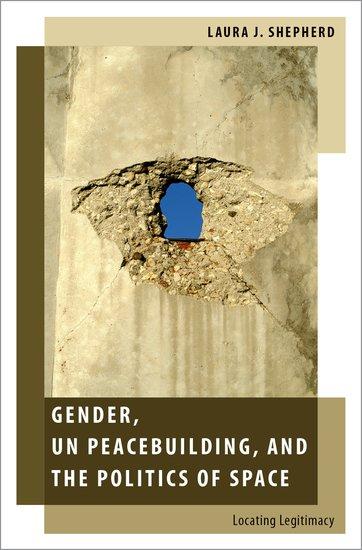 Gender, UN Peacebuilding, and the Politics of Space: Locating Legitimacy, Laura J. Shepherd (New York: Oxford University Press, 2017), 264 pp., $74 cloth.
Gender, UN Peacebuilding, and the Politics of Space: Locating Legitimacy, Laura J. Shepherd (New York: Oxford University Press, 2017), 264 pp., $74 cloth.
The United Nations Peacebuilding Commission (UNPBC) was established in 2005 to give a boost to the UN’s efforts to uphold international peace and security. With its focus on assisting post-conflict countries in moving toward recovery, reintegration, and reconstruction and laying the foundation for sustainable development, the new peacebuilding architecture represented for many, including Laura J. Shepherd, a new hope. Specifically, it is hope both for people in conflict-affected areas and for the UN itself, which had been accused of not just failing in its mandate but even, through an approach to peacekeeping that merely trapped conflicts in a stalemate, perpetuating suffering. For feminists in particular, the creation of the new peacebuilding architecture inspired optimism because it was the first UN body to have a gender dimension explicitly built into its founding resolutions. As such, the UNPBC could champion the UN’s Women, Peace, and Security agenda, which urges international actors to consider the gendered differences inherent in conflict when developing peacebuilding solutions, and thus realize gains for women.
In an important contribution to the assessment of this peacebuilding architecture, Shepherd focuses on the UNPBC’s understanding of peacebuilding, arguing convincingly that the ways in which the United Nations comprehends and simultaneously constructs peacebuilding matter, making some realities possible and proscribing others. Through rigorous and rich discourse analysis, Shepherd interrogates not only how the UN understands peacebuilding itself but also how it understands gender, women, and civil society. The book is structured accordingly, with a chapter focusing on each of the four topics, along with a valuable introduction justifying the approach and a conclusion that draws the main threads of the argument together.
In the first chapter Shepherd argues that UNPBC discourse functions to produce a narrow understanding of peacebuilding as state building. This location of legitimacy in the state ultimately shores up the sovereign state system—one that is highly masculinized. Shepherd’s decision to complement document analysis with interviews from UNPBC staff and other insiders proves rewarding, as it results in some revealing quotes to illustrate her points. As one staffer admits, “We all have a very unclear sense of what [peacebuilding] means. . . . The one thing we know the hard way is that it involves getting quite deep into the trousers of sovereignty just when sovereignty is at its most fragile and prickly” (pp. 67–68). This fragility, Shepherd notes, is a feature that sovereignty shares with masculinity. But sovereignty is not just fragile like masculinity; rather, the fragilities of masculinity and sovereignty are deeply intertwined. The outcome is that “configurations of power and authority . . . that historically . . . have excluded women from the domain of formal politics” thus go unchallenged (p. 66).
The chapter on gender makes for fascinating if depressing reading. Despite the gender mandate of the UNPBC, the Women, Peace, and Security agenda is hardly mentioned in UNPBC discourse. Moreover, Shepherd contends that the Commission’s discourse may say “gender,” but it means “women,” and this understanding positions the subject of “woman” as subordinate to “man” in a hierarchy of gendered power. This matters, she argues, because it exacerbates the exclusion of women from formal and informal political spaces and perpetuates economic, cultural, and political discrimination and violence against women. As Shepherd quips, the category of woman “has not historically been a politically efficacious subject position to occupy” (p. 102). In short, “The UN is creating not so much ‘conditions of possibility,’ per Foucault, but ‘conditions of impossibility’ structuring gender-responsive peacebuilding at the UN” (p. 35).
Turning to examine how the UNPBC discourse frames women themselves, Shepherd argues that women are associated with civil society in ways that circumscribe their meaningful participation in the “high politics” of peacebuilding through, for example, formal peace negotiations or economic planning. Likewise, when it discusses women’s economic empowerment, UN peacebuilding discourse “confines women (as entrepreneurs) to particular spatial domains (the market) while excluding them from others (the institutions of formal politics)” (p. 167). Shepherd notes that the UNPBC’s discourse implies that empowering women economically is a technical exercise, an understanding found across the UN system; whereas for many feminists, economic empowerment of women requires collective action for structural change, not just facilitating their engagement in markets.
The argument that what we see in UN discourse is the depoliticization of women’s economic empowerment in ways that leave “undisturbed the racialized and gendered foundations of neoliberal capitalism” (p. 168) is convincing, but overall there is a sense that Shepherd is inclined to see the “conditions of impossibility” often at the expense of any “conditions of possibility,” despite her claim to be attuned to hope, and this lends the book something of a fatalistic feel. For example, she reads the UNBPC’s consistent reference to “civil society, including women’s organizations” as linking civil society and women’s organizations in ways that feminize and delegitimize civil society. The framing could alternatively be interpreted, however, as an expression of the UN’s recognition that they are not one and the same thing, and that if women’s organizations are not specifically named they will be overlooked.
If the explicit call for the inclusion of women’s organizations in peacebuilding is a problem, one wonders what would count as a progressive discursive framing. But while one might quibble with particular interpretations of the discourse, as in this case, Shepherd is so thorough in laying out her thinking and the source texts that the book serves as a useful resource for further debate on how the UN understands peacebuilding, gender, women, and civil society, and the possibilities its constructions permit or prohibit. Indeed, Gender, UN Peacebuilding, and the Politics of Space should be essential reading for all scholars and students interested in the UN’s efforts to uphold international peace and security.
—Claire Duncanson
Claire Duncanson is senior lecturer in international relations at the University of Edinburgh and is the author of Gender and Peacebuilding (2016).
More in this issue
Summer 2018 (32.2) • Essay
The Social Cost of International Investment Agreements: The Case of Cigarette Packaging
In this essay, Jennifer L. Tobin argues that international investment agreements impinge on states’ domestic regulatory sovereignty in unforeseen ways, and that these hidden social ...
Summer 2018 (32.2) • Review
Just War Thinkers: From Cicero to the 21st Century, edited by Daniel R. Brunstetter and Cian O’Driscoll
This volume provides an overview of the development of just war thinking over the centuries through a series of contextualized snapshots of individuals whose work ...

Summer 2018 (32.2) • Feature
Threats and Coercive Diplomacy: An Ethical Analysis
Threats of armed force are frequently employed in international affairs, yet they have received little ethical scrutiny in their own right. This article addresses that ...